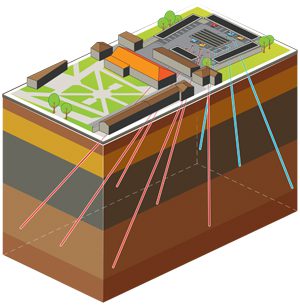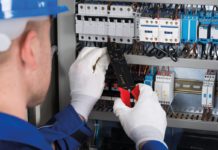Kevin Stickney, Managing Director of Erda Energy – a company supplying clean energy technologies and solutions to firms – asks why we’re lagging on decarbonising heat in the UK and argues it’s time for the industry to up its game. He also makes the case for “geo-exchange technology”, a speciality of his own firm.
Winter, at last, seems to be over. But it had a sting in its tail which most of us won’t forget in a hurry. The Beast from the East will no doubt have had many of us reaching for the thermostat, wincing at the thought of the bill. A growing number of us will also have been grimacing at the thought of burning even more fossil fuels to heat our homes and businesses. That’s because, despite our fantastic progress in decarbonising our electricity, we’ve yet to see anything like the same success in greening our heat supply.
But we need to. Heating makes up 32% of our total emissions, far ahead of power (21%) and transport (24%) . We need a credible pathway to zero carbon heating.
What are the options?
There are those that root for burning low carbon fuels, such as biomass, for heat. Others advocate replacing or augmenting our natural gas network with hydrogen or biogas. Combined heat and power (CHP) systems – which convert a single fuel into both electricity and heat in a single process at the point of use – have also had a positive impact so far, but their future is limited due to a changing electricity grid.
However, burning biomass, biogas or waste still produces carbon emissions, even if offset by the growth of crops. There are also questions around land-use conflicts for biofuels and the wisdom of dependency on waste streams. Hydrogen seems more promising, but all current methods for producing it at scale are themselves carbon intensive.
The other route is electrifying our heat. The advantage here is that there are no carbon emissions from the heating itself, only from the power generation that supplies it. Our power in the UK isn’t zero-carbon yet, but we have a clear and credible pathway for making it so and a proven track-record for progress – between 1990 and 2015 emissions fell by almost half and are set to fall 70% by 2020 from 2010 levels .
Learning lessons
In fact, that track record of decarbonisation in power is something we can look to for lessons in heating. It’s not always been a smooth process, but what has allowed for success? Continued investment in ever cheaper and more efficient renewable energy technologies is part of, but not the whole story.
One aspect is the need for a well-designed incentive regime. The Renewable Heat Incentive (RHI) was a good attempt that has helped to reduce carbon. That said, the National Audit Office estimates it is set to meet only one fifth of the government’s target for installations by 2021, so some modifications are needed. We also need to update building regulations, which require developers to tick boxes based on outdated understanding of the technology available. Building regulations also need a revamp given that – owing to rapid changes in the electricity grid in recent years – the carbon content of the network is now much lower than what designers are permitted to use in the buildings. We are missing opportunities to encourage further carbon reductions.
Decarbonisation of the grid also owes a lot to the creation of a smarter grid. By connecting up previously distinct but complementary systems, you can create new efficiencies. So, in heat, we should also be looking at cooling. Done right, they can be two sides of the same coin and mutually supportive. For example, supermarkets’ refrigeration – even after optimisation – creates a huge amount of “waste” heat that could be used by local homes and businesses – and vice versa.
The other big ‘smart’ element for power grids has been the ability to time-shift supply and demand to better match the two. Demand side response schemes are one way, and battery storage is the much-anticipated final piece of the puzzle here. However, in heating, we’ve had that puzzle-piece for a long time already.
Geo-exchange technology – as the name implies – exchanges heat between a source and destination. Powered by electricity, it can be used for heating or cooling. This exchange can allow for time-shifting energy by capturing energy at times when you don’t need the heat.

Upping our game
If it’s clear that electrification is a viable route to zero-carbon, and we have proven geo-exchange systems (plus air source heat pumps and other geothermal technologies) then it begs the question: why isn’t there more of it? Why the lack of enthusiasm?
There’s no use laying the blame on the government. Yes, tweaking incentive regimes would be helpful. Yes, it’s fair to say that we need to see the same focus that was spent on decarbonisation of power (and now, increasingly, transport) brought to bear on heat. However, we as an industry need to accept that we haven’t done enough – we’ve created our own performance gap.
Ground and air source heat pumps have existed for decades, yet too often systems have been let down by immature technology delivering lacklustre performance. Coefficients of performance (CoP) of two are assumed to be the norm, and those figures often don’t add up to a viable investment case in either carbon or financial terms. Investment in innovative engineering has been lacking.
Nor has there been enough focus on total systems thinking; integrating renewable heat systems with complementary technologies such as frequency response, renewable generation and district energy networks.
The sector has drifted along, picking up projects where developers are keen to show green credentials but reaching only a fraction of its commercial and environmental potential. We need to do better.
Geo-exchange technology can make that difference. CoPs of more than four are common, meaning the energy output in heat is quadruple that input as electricity. Carbon-intensity depends on that electrical input, which could be zero-carbon if paired with onsite renewables, but is falling all the time even for the grid. For our systems, we publish live energy and carbon performance metrics, based on data from Elexon and systems in-the-field and independently verified by the University of Oxford.
It’s our job in the industry to make smart, electric renewable heating systems a no-brainer. To make the commercial and environmental case so compelling that the market has no choice but to sit up and take notice. High-performance, smart electric heating (and cooling) systems like geo-exchange offer a clear and credible path to zero-carbon as part of a proven eco-system of renewable technologies. It’s a path we can’t afford not to take.







